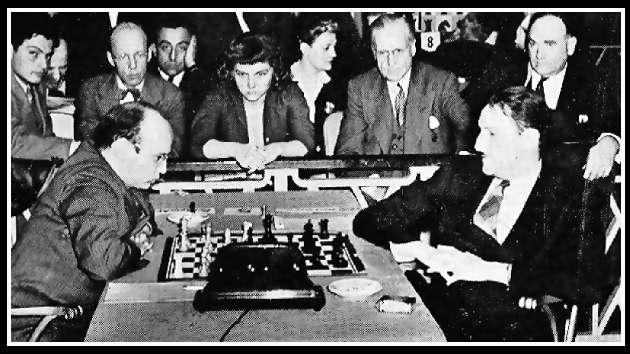The United States in the 1940s had many splendid chess players such as Sammy Reshevsky, Reuben Fine, Al Horowitz and Isaac Kashdan. The following story involves all those legends in some fashion.
Reuben Fine, besides being one of the strongest players in the world, earned some pocket change writing a monthly article for Horowitz' "Chess Review." The monthly contribution in which Fine annotated particularly interesting or important games for the readers was called "Game of the Month".
But let's regroup for a minute.
The U.S. Championship of 1942 was held at the Hotel Astor in New York City starting on April 10th. It lasted 15 rounds and ended on April 30th with a tie between Reshevsky and Kashdan. This story is about this 15th round.
 Isaac Kashdan and Sammy Reshvesky bookend N. May Karff, the 1942 U.S. Women's Champion.
Isaac Kashdan and Sammy Reshvesky bookend N. May Karff, the 1942 U.S. Women's Champion.
Herman Steiner (5th), Arnold Denker (3rd-4th) and Albert Pinkus (3rd-4th) stand behind them.
Kashdan called himself and Reshevsky "co-champions pro-tem" as there was to be a play-off for the title. That play-off took place in December 1942. Reshevsky again won, depriving Kashdan of his best chance ever for that honor.
Kashdan had never been U.S. Champion while Reshevsky had been the perennial champion since 1936 (1939, 1938 1940 and 1941). In Kashdan's own words:
"I am thinking back to 1934, when I challenged Frank Marshall to a match for the American Championship, and the number of times I have tried for the title since. This is my best chance...."
* * * * * * * * * * * * * * * * * * * * * * * * * * * * *
Now in the 15th and final round, all that needs to happen is for Kashdan to beat Irving Chernev (which he does quite handily) and for Horowitz to beat Reshevsky, a tricky proposition. After beating Chernev, Kashdan could watch the more tedious and nerve-wracking bout between Horowitz and Reshevsky.
Horowitz, who had a strong start, followed by a brief losing streak, had no chance of winning the tournament but relished the idea of beating Reshevsky and as it happened, WAS beating Reshevsky in this game with a material advantage (connected passed pawns after move 66, no less) going into the finally phase with a very complex position and an atmosphere charged with tension.
The unadorned game.
Reuben Fine chose this important game as his "Game of the Month" for May 1942 (the cover for which is shown above). All the annotations below are Fine's. Fine's main contention is that Reshevsky played too defensively, essentially handing the game over to Horowitz. Horowitz in turn, along with all the kibitzers, missed a winning line, what Kashdan called "a very easy one, too, once we see it" and the "won game" resulted in a draw thanks to Reshevsky's technique.

12. Kb1 "The first in a series of timid moves which results in a lost position. Since the object of castling on the queen's wing is to attack on the other side there is no reason for not beginning immediately with 12. g4! Black can hardly afford to accept the sacrifice and give White two full tempi for his assault. Likewise 12...g5?; 13. Bg3 is suicidal. Nor is the counter-sacrifice 12....Ne4; 13.Bxe4 dxe4; 14.Nxe4 to be feared. Black would indeed have nothing better than 12...b5, but in that event 13. g5 opens up the Knight file and secures a position where White's advantage in development is a great handicap for Black to overcome."
"The ending is not easy for either side. White is guided by the thought of exchanging as many Pawns as possible, but he must be careful not to allow his opponent two connected passed Pawns. Black, on the other hand, would like to secure chances on both sides of the board (a cardinal principle in endings with Bishops of opposite colors). Before that is done he must not let the Rooks disappear from the board."

Game adjourned

58....Bc4?? Throwing away a certain and well-earned win (there should be a law passed making it a criminal offense for Reshevsky to secure a lost position in the last round of a tournament!) The win proceeds.


"It is evident that Black can win only by sacrificing the exchange and rushing up his Passed Pawns. It is also known that the ending of Bishop +2 Pawns can reach the sixth rank. This is not the case here, which explains why the game was drawn so quickly."



and so the story goes...



 Isaac Kashdan and Sammy Reshvesky bookend N. May Karff, the 1942 U.S. Women's Champion.
Isaac Kashdan and Sammy Reshvesky bookend N. May Karff, the 1942 U.S. Women's Champion.














